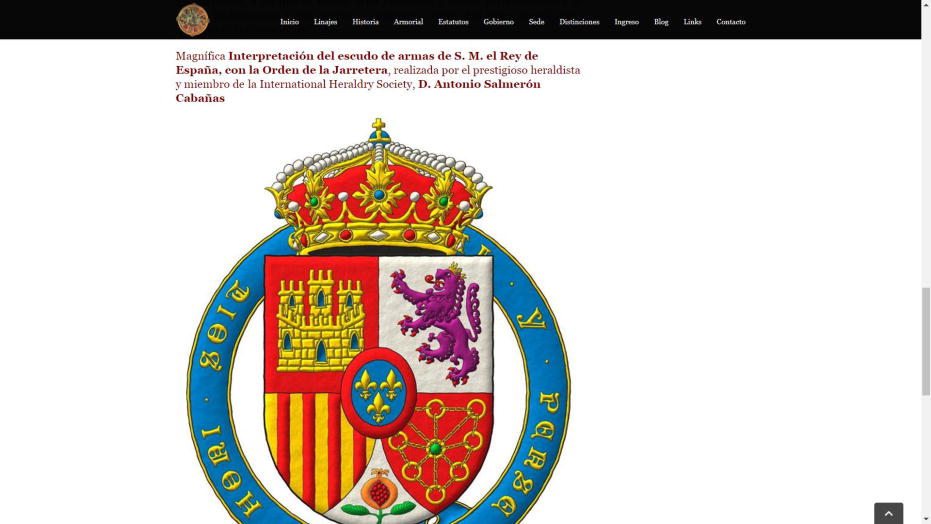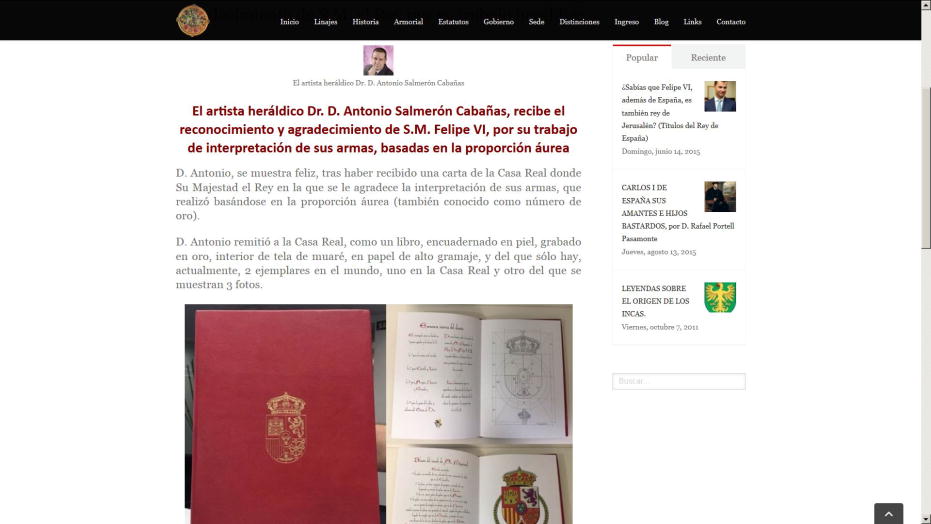In the fess point


Blasón de Navarra en el armorial Urfé
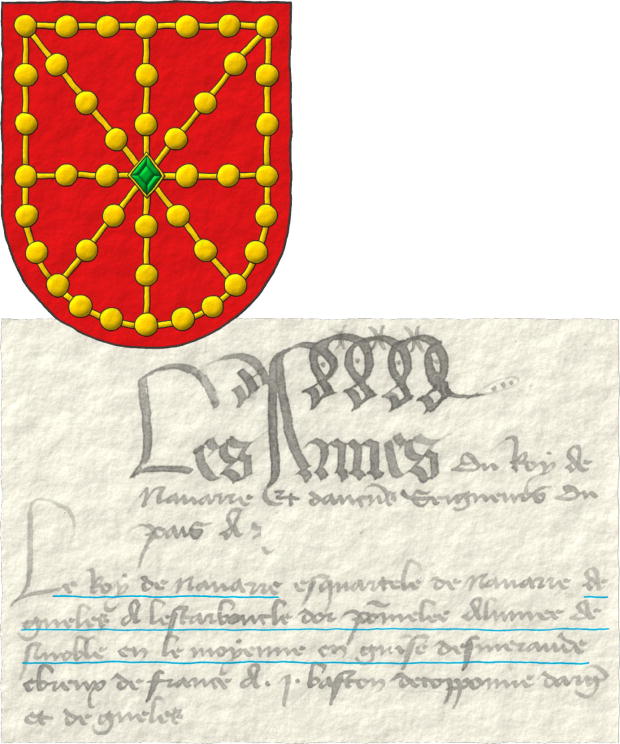
Escudo de gules, un carbunclo cerrado, pomelado de oro; cargado en el centro de una esmeralda en forma de losange de sinople.
The armorial [Urfé; 15th century] contains only blazons written in French and is not decorated with shields.
The image shows my interpretation of the arms and, beneath it, the blazon of the king of Navarre as follows «Le Roy de Navarre... de gueles à l'escarboucle d'or pommelée alumée de sinoble en la moyenne en guise d'esmeraude» which could be translated as «The King of Navarre... Gules, a carbuncle Or pommetty, illuminated Vert in the middle in the manner of an emerald».
Note that the blazon does not suggest the presence of an emerald, but that the place corresponding to the central boss of the shield, from which the rays of the carbuncle emerge, is enamelled Vert.
In the article Universitas Studiorum Navarrensis about the arms of the University of Navarre I interpret the arms of Navarre borne in profile by the Archangel Saint Michael, which, by my way of painting it, lies halfway between the carbuncle and the chains, with round chain links and long carbuncle rays, where at the centre there is no emerald, but a Vert enamel in the manner of an emerald.
Blazon keywords: Without divisions, Gules, One, Carbuncle, Pommelled, Or, Charged, In the fess point, Emerald, Vert and Lozenge.
Style keywords: Soft metal, Illuminated, Outlined in sable and Shaded.
Classification: Interpreted, Civic and Coat of arms.
Bearer: Navarre.


![Ver [Bosque, J. del; 1540] en referencias bibliográficas. Libro abierto, hojas de plata, filo de oro, guardas de gules, tapas de sable.](../css/Libro.Bibliografia.png)
Bosque, J. del; 1540
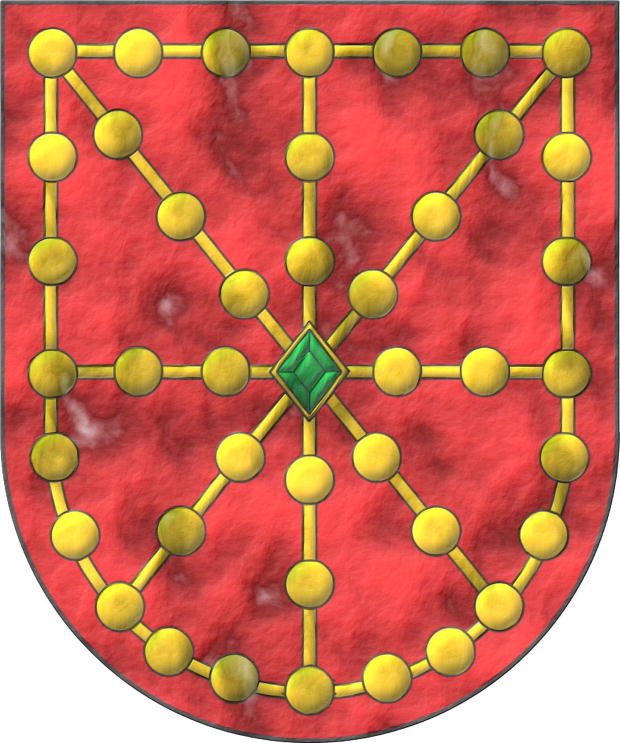
Juan del Bosque, «Libro de Armería del Reino de Navarra», which is currently missing and whose subsequent copy, commissioned in 1572, is kept in the Royal and General Archive of Navarre, estimated year of creation 1540.
The origin of this armorial dates back to 1527, when the Navarrese Courts requested that the Royal Council and the Chamber of Comptos ~ Chamber of Accounts and Fiscal Control, record in a book the coats of arms of the kingdom of Navarre starting with that of the king of Navarre and the houses and lineages of the so-called «ricoshombres», Almorrabides, Guebara, Aybar, Baztanes, Urroz, Lete, Subiça, Rada, Vidaurre, Qasqante, Monteagudo, and Mauleón, also including the coats of arms of other manors, houses, valleys, towns, and nobles [Valverde Ogallar, P. B.; 2001; page 326].
According to [Martinena Ruiz, J. J.; 1982; page 35] the book was compiled around the year 1540, and this is the date I use for referencing this armorial.
This first manuscript created by Juan del Bosque was taken by the royal visitor Hernán Suárez de Toledo, under the pretext of taking it to Emperor Charles V, despite being requested back by the Navarrese Courts, it was never returned and was definitively lost. The armorial that has come down to us is a recreation commissioned in 1572 [Valverde Ogallar, P. B.; 2001; page 327].
According to [Menéndez Pidal de Navascués, F.; 1974; page 19] the recreation of this armorial was carried out based on certifications, such as those from the herald Azcárraga, and notes and partial copies of the stolen book, like the copy kept in the monastery of Leyre.
Another noteworthy bibliographic reference about this armorial, in addition to those previously mentioned, is [Martinena Ruiz, J. J.; Menéndez Pidal de Navascués, F.; 2001].
The image illustrating this bibliographic reference is the coat of arms of the king of Navarre, which I recreated based on the illustration in this armorial, on its first folio according to the numbering given to it in 1613.
Bibliographical reference of century XVI.
Author: Bosque, Juan del.
Bibliographic reference mentioned in the following articles:
- Almorrabides of Navarre
- Aybar of Navarre
- Baztanes of Navarre
- Guebara of Navarre
- Lete of Navarre
- Martinena Ruiz, J. J.; 1982
- Martinena Ruiz, J. J.; Menéndez Pidal de Navascués, F.; 2001
- Mauleón of Navarre
- Menéndez Pidal de Navascués, F.; 1974
- Menéndez Pidal de Navascués, F.; 1985
- Menéndez Pidal de Navascués, F.; Martínez de Aguirre, J.; 2000
- Monteagudo of Navarra
- Navarra, closed carbuncle
- Navarre
- Noblemen of Navarre
- Qasqante of Navarre
- Rada of Navarre
- Subiça of Navarre
- Urroz of Navarre
- Vidaurre of Navarre


Crown of Her Royal Highness Doña Leonor Princess of Asturias
![Crown of Her Royal Highness Doña Leonor Princess of Asturias Quarterly: 1 Gules, a castle triple-towered Or, port and windows Azure, masoned Sable [for Castile]; 2 Argent, a lion rampant Purple, armed and langued Gules, crowned Or [for Leon]; 3 Or, four pallets Gules [for Aragon]; 4 Gules, a chain orlewise, crosswise, and saltirewise Or, charged in the fess point with an emerald Vert [for Navarre]; enté en point Argent, a pomegranate proper, seeded Gules, slipped and leaved Vert [for Granada]; an inescutcheon Azure, three fleurs de lis Or, 2 and 1, a bordure Gules [for Bourbon]; and the whole debruised by a label of three points Azure. Crest: A Crown of Prince. The shield is surrounded by the Golden Fleece.](../escudo_armas/LeonorPA.27.Corona.Preciosas.Toison.Irisado.jpg)
Quarterly: 1 Gules, a castle triple-towered Or, port and windows Azure, masoned Sable [for Castile]; 2 Argent, a lion rampant Purple, armed and langued Gules, crowned Or [for Leon]; 3 Or, four pallets Gules [for Aragon]; 4 Gules, a chain orlewise, crosswise, and saltirewise Or, charged in the fess point with an emerald Vert [for Navarre]; enté en point Argent, a pomegranate proper, seeded Gules, slipped and leaved Vert [for Granada]; an inescutcheon Azure, three fleurs de lis Or, 2 and 1, a bordure Gules [for Bourbon]; and the whole debruised by a label of three points Azure. Crest: A Crown of Prince. The shield is surrounded by the Golden Fleece.
Arms emblazoned by me, highlighted with lights and shadows, outlined in Sable, with a semi-circular outer contour and with a iridescent finish.
This is my interpretation of the coat of arms of Her Royal Highness Doña Leonor Princess of Asturias (as heiress to the Crown of Castile), Princess of Girona (as heiress to the Crown of Aragon), and Princess of Viana (as heiress to the Kingdom of Navarre), with the Collar of the Distinguished Order of the Golden Fleece. Her coat of arms is that of her father, the King, charged with a label Azure and surmounted by the crown of a princess with four pearl diadems, three visible.
Blazon keywords: Gules, Azure, Purpure, Vert, Or, Argent, One, Three, Four, Quarterly, Castle, Triple-towered, Port and windows, Masoned, Lion, Rampant, Crowned, Pallet, Chain, Orlewise, Crosswise, Saltirewise, Charged, In the fess point, Emerald, Enté en point, Pomegranate, Proper, Slipped, Leaved, Inescutcheon, Fleur de lis, Ordered, Bordure, Cadency, Label of three points, Crown of Prince, Crown, Surrounded and Collar.
Style keywords: Outlined in sable, Illuminated, Semi-circular and Iridescent.
Classification: Personal, Kingdom of Spain, Interpreted, Boa and Coat of arms.
Bearer: Leonor Princess of Asturias.


![Ver [Felipe VI and the Order of the Garter in Twelve Lineages] en enlaces recomendados. Áncora de oro y la divisa enlace.](../css/Ancora.Enlace.png)
Felipe VI and the Order of the Garter in Twelve Lineages
Publication of my interpretation of the arms of His Majesty King Felipe VI with the Order of the Garter on the blog Twelve Lineages of Soria with the following text: Magnificent interpretation of the coat of arms of H.M. the King of Spain, with the Order of the Garter, made by the prestigious heraldist and member of the International Heraldry Society, Mr. Antonio Salmerón Cabañas.
Categories: Link, Or, Four, Pale, Gules, Azure, Sable, One, Castle, Port and windows, Masoned, Argent, Purpure, Lion, Rampant, Armed, Langued, Crowned, Chain, Orlewise, Crosswise, Saltirewise, Charged, In the fess point, Emerald, Vert, Closed royal crown, Crown, Inescutcheon, Fleur de lis, Bordure, Enté, In base, Pomegranate, Proper, Seeded (pomegranate), Slipped and Leaved.
Root: Twelve Lineages of Soria.


![Ver [Felipe VI in Twelve Lineages] en enlaces recomendados. Áncora de oro y la divisa enlace.](../css/Ancora.Enlace.png)
Felipe VI in Twelve Lineages
Publication of my interpretation of the arms of His Majesty King Felipe VI on the blog Twelve Lineages of Soria in an article entitled The heraldic artist Dr. Antonio Salmerón Cabañas receives the recognition and gratitude of H.M. Felipe VI for his interpretation of the royal arms based on the golden ratio and, later, in another article entitled The eminent heraldist Mr. Antonio Salmerón Cabañas interprets the arms of H.M. King Felipe VI.
Categories: Link, Or, Four, Pale, Gules, Azure, Sable, One, Castle, Port and windows, Masoned, Argent, Purpure, Lion, Rampant, Armed, Langued, Crowned, Chain, Orlewise, Crosswise, Saltirewise, Charged, In the fess point, Emerald, Vert, Closed royal crown, Crown, Inescutcheon, Fleur de lis, Bordure, Enté en point, Pomegranate, Proper, Seeded (pomegranate), Slipped and Leaved.
Root: Twelve Lineages of Soria.


Jesus Christ
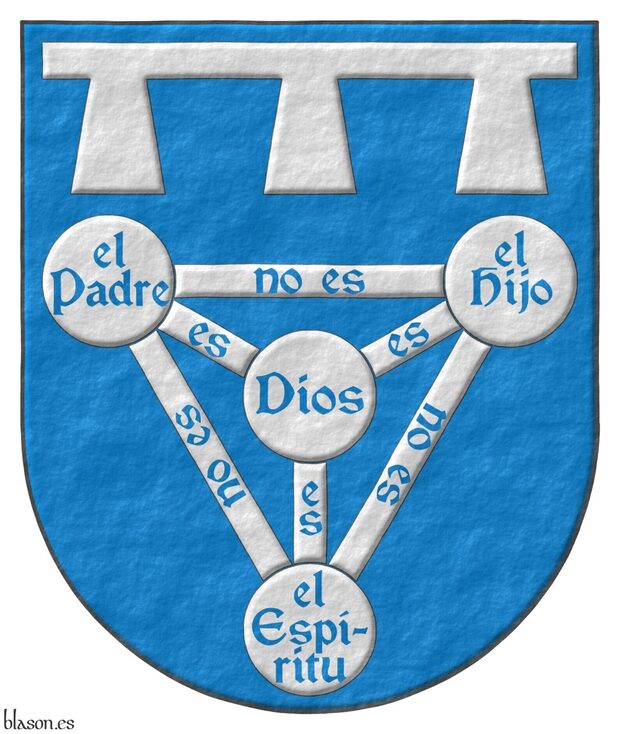
Azure, a pall couped Argent, its three arms charged with «es» Azure, within a triangle reversed Argent, its three arms charged with «no es» Azure, all debruised by four plates, three on the vertex of the triangle, in dexter chief, charged with «el Padre», in sinister chief, charged with «el Hijo», in base, charged with «el Espítiru», and one on the fess point, charged with «Dios» Azure; in chief a label of three points Argent.
Escudo de azur, una perla recortada de plata, sus tres brazos cargados con «es» de azur, dentro de un triángulo ranversado de plata, sus tres brazos cargados con «no es» de azur, todo resaltado de cuatro bezantes de plata, tres sobre los vértices del triángulo, en la diestra del jefe, cargado de «el Padre», en la siniestra del jefe, cargado con «el Hijo», en la punta, cargado con «el Espítiru» y uno sobre el corazón, cargado con «Dios» todo de azur; en jefe un lambel de tres pendientes de plata.
Imaginary coat of arms that I have interpreted with: a semicircular (round) base; its field illuminated in Azure; the rest illuminated in Argent and outlined in Sable; its letters in plain Azure ink; and the set with a rough finish.
Drawing a parallel between the coat of arms of Navarre that [[Menéndez Pidal de Navascués, F.; 1974]] transcribes for its original coat of arms as «Gules, a closed and pommetty carbuncle Or with an emerald...» I have characterized the pearl on the coat of arms as closed.
This is the imaginary coat of arms of the Holy Trinity with a label added for difference to the Son, to Jesus Christ.
Blazon keywords: Without divisions, Azure, One, Pall, Couped, Argent, Three, Charged, Letter, Within, Triangle, Reversed, Four, Plate, In the dexter chief, In the sinister chief, In base, In the fess point, Cadency and Label of three points.
Style keywords: Semi-circular, Illuminated, Outlined in sable and Rough.
Classification: Religious, Interpreted, Imaginary and Coat of arms.
Imaginary bearer: Jesus Christ.


Jesus Christ, with bezants Or
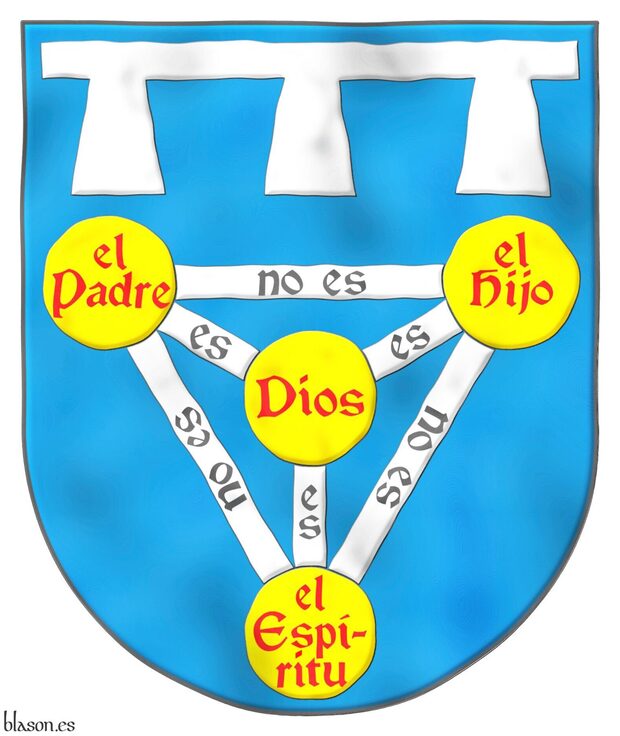
Azure, a pall couped Argent, its three arms charged with «es» Sable, within a triangle reversed Argent, its three arms charged with «no es» Sable, all debruised by four bezants, three on the vertex of the triangle, in dexter chief, charged with «el Padre», in sinister chief, charged with «el Hijo», in base, charged with «el Espítiru», and one on the fess point, charged with «Dios» Gules; in chief a label of three points Argent.
Escudo de azur, una perla recortada de plata, sus tres brazos cargados con «es» de sable, dentro de un triángulo ranversado de plata, sus tres brazos cargados con «no es» de sable, todo resaltado de cuatro bezantes de oro, tres sobre los vértices del triángulo, en la diestra del jefe, cargado de «el Padre», en la siniestra del jefe, cargado con «el Hijo», en la punta, cargado con «el Espítiru» y uno sobre el corazón, cargado con «Dios» todo de gules; en jefe un lambel de tres pendientes de plata.
Imaginary coat of arms that I have interpreted as follows: its base is semicircular (round); its field is illuminated in Azure; the rest is illuminated in Argent and outlined in Sable, except for the bezants which are Or and also outlined in Sable; its letters in plain tinctures, some Gules and others Sable; and the set with a glazed finish.
Pall
The pall (perla) as defined by [Avilés, J.; 1780a; page 239] is «a figure composed of three moving cotises, or that emerge from the two angles of the Chief and the Base, which meet in the center or heart of the Shield in the form of a Greek Y, as if this figure were formed from a half Saltire, and a half Pale».
Blazon keywords: Without divisions, Azure, One, Pall, Couped, Argent, Three, Charged, Letter, Sable, Within, Triangle, Reversed, Four, Bezant, In the dexter chief, In the sinister chief, In base, In the fess point, Gules, Cadency and Label of three points.
Style keywords: Semi-circular, Illuminated, Outlined in sable and Glass.
Classification: Religious, Interpreted, Imaginary and Coat of arms.
Imaginary bearer: Jesus Christ.


Leonor Princess of Asturias
![Leonor Princess of Asturias Quarterly: 1 Gules, a castle triple-towered Or, port and windows Azure, masoned Sable [for Castile]; 2 Argent, a lion rampant Purple, armed and langued Gules, crowned Or [for Leon]; 3 Or, four pallets Gules [for Aragon]; 4 Gules, a chain orlewise, crosswise, and saltirewise Or, charged in the fess point with an emerald Vert [for Navarre]; enté en point Argent, a pomegranate proper, seeded Gules, slipped and leaved Vert [for Granada]; an inescutcheon Azure, three fleurs de lis Or, 2 and 1, a bordure Gules [for Bourbon]; the whole debruised by a label of three points Azure.](../escudo_armas/LeonorPA.21.CoA.TrazoAlzado.jpg)
Quarterly: 1 Gules, a castle triple-towered Or, port and windows Azure, masoned Sable [for Castile]; 2 Argent, a lion rampant Purple, armed and langued Gules, crowned Or [for Leon]; 3 Or, four pallets Gules [for Aragon]; 4 Gules, a chain orlewise, crosswise, and saltirewise Or, charged in the fess point with an emerald Vert [for Navarre]; enté en point Argent, a pomegranate proper, seeded Gules, slipped and leaved Vert [for Granada]; an inescutcheon Azure, three fleurs de lis Or, 2 and 1, a bordure Gules [for Bourbon]; the whole debruised by a label of three points Azure.
Escudo cuartelado: 1o de gules, un castillo de oro, aclarado de azur, mazonado de sable [de Castilla]; 2o de plata, un león rampante de púrpura, lampasado y armado de gules, coronado de oro [de León]; 3o de oro, con cuatro palos de gules [de Aragón]; 4o de gules, una cadena puesta en orla, en cruz y en sotuer de oro, cargada en el centro de una esmeralda de sinople [de Navarra]; entado en punta de plata, una granada al natural, tajada de gules, tallada y hojada de sinople [de Granada]; un escusón de azur, tres flores de lis de oro, 2 y 1, una bordura de gules [de Borbón]; brisado de un lambel de tres pendientes de azur.
Coat of arms painted by me, highlighted with lights and shadows, outlined in Sable, with a semi-circular external shape and with a freehand finish.
This is the coat of arms of Her Royal Highness Doña Leonor Princess of Asturias, Princess of Girona, and Princess of Viana, heiress of the throne of Spain as the elder daughter of King Felipe VI and Queen Letizia. This version of her coat of arms has been emblazoned by me.
Blazon keywords: Gules, Azure, Purpure, Vert, Or, Argent, One, Three, Four, Quarterly, Castle, Triple-towered, Port and windows, Masoned, Lion, Rampant, Crowned, Pallet, Chain, Orlewise, Crosswise, Saltirewise, Charged, In the fess point, Emerald, Enté en point, Pomegranate, Proper, Slipped, Leaved, Inescutcheon, Fleur de lis, Ordered, Bordure, Cadency and Label of three points.
Style keywords: Outlined in sable, Illuminated, Semi-circular and Freehand.
Classification: Personal, Kingdom of Spain, Interpreted, Boa and Coat of arms.
Bearer: Leonor Princess of Asturias.


Navarre
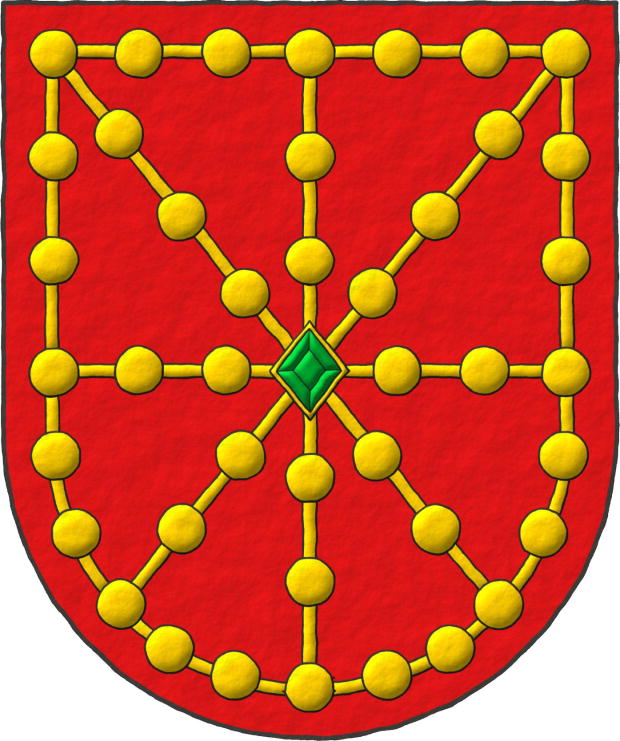
Escudo de gules, un carbunclo cerrado, pomelado de oro; cargado en el centro de una esmeralda en forma de losange de sinople.
Original coat of arms of Navarre interpreted with: a semicircular (round) base; the field in flat Gules; the pommetty carbuncle illuminated in Or and outlined in Sable; the emerald illuminated in Vert and also outlined in Sable; and the whole finished with a raised-stroke effect.
In the armorial [Urfé; Siglo XV; indexed on folio 151, but actually written on 142] the arms of Navarre are blazoned in French as «de gueles à l'escarboucle d'or pommelée alumée de sinoble en la moyenne en guise d'esmeraude», it only gives the blazon, since this armorial is not illustrated.
An image of the original French blazon text can be seen in the article Blazon of Navarre in the Urfé armorial.
The interpretation of the arms of Navarre shown here is based on the one illustrated in the armorial [Bosque, J. del; 1540; folio 1 of the 1613 numbering], which is its main plate, with the arms of the king of Navarre surrounded by the coats of arms of the lineages and manors of his «ricoshombres», twelve lineages in total.
In [Menéndez Pidal de Navascués, F.; 1963] one can consult his view on what is, probably, the real origin of the arms of Navarre, which he bases on:
- The existence of a defensive element of the shield called the boss, placed at its center. This element already existed in classical Rome, on the shields of the legionaries and, in addition, it could serve to keep small valuables inside.
- The later reinforcement of this boss with 8 spokes, that is, 4 diameters set vertically, horizontally, bendwise and bendwise sinister, giving rise to a radiated boss to strengthen the shield.
- This radiated boss on rich shields could be very elaborate and even be adorned with gems, thus becoming an ornamental element.
- The evolution of the radiated boss from a defensive and ornamental element to the so-called carbuncle, but now as a heraldic element with a radial structure. Originally the carbuncle was a mystical stone, comparable to the ruby, that emitted an intense light capable of illuminating the knight in the darkness of night. Heraldically the name carbuncle is used to denote a scheme of radial rays and not the marvellous stone that emitted them and from which it borrows its name.
- This eight-rayed carbuncle, joined at the ends forming a closure, like an orle, and decorated with pommels, on a field Gules, and with an emerald overall at its center is what constitutes the arms of Navarre.
Regarding the importance of the radiated boss and the carbuncle, not only in the arms of Navarre but in heraldry in general, [Menéndez Pidal de Navascués, F.; 1963] goes a step further when he writes «although it has never been pointed out, it seems evident to us the influence of this piece on the classic partitions of the shield, contained in the four diametral lines that compose it». He makes us see that «cortado, partido, tronchado y tajado» and, therefore also, «cuartelado, en sotuer y jironado», do not have their origin in the different ways of striking a shield with a sword, as illustrated, for example, in [Avilés, J.; 1725a; plate 18, illustrations 23, 24, 25 and 25], but in different ways of selecting, as delimiters, the four diameters of the carbuncle.
Blazon keywords: Without divisions, Gules, One, Carbuncle, Pommelled, Or, Charged, In the fess point, Emerald, Vert and Lozenge.
Style keywords: Freehand, Illuminated and Outlined in sable.
Classification: Interpreted, Civic and Coat of arms.
Bearer: Navarre.


![Ver [The Heraldry Society; 2013] en referencias bibliográficas. Libro abierto, hojas de plata, filo de oro, guardas de gules, tapas de sable.](../css/Libro.Bibliografia.png)
The Heraldry Society; 2013
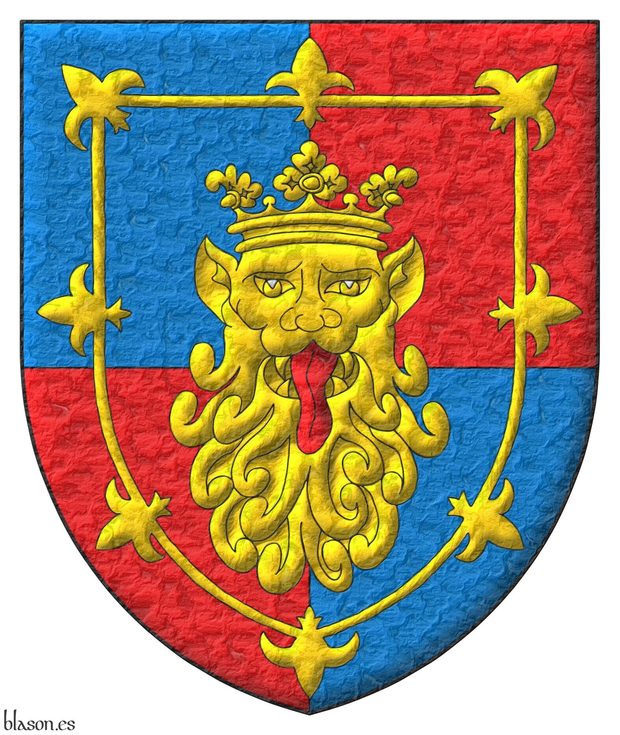
The Heraldry Society, «Education Pack, A brief explanation of Heraldry for teachers together with explanatory sheets and templates for students», Baldock, Hertfordshire, 2013.
This bibliographical reference is illustrated with the quartered coat of arms of The Heraldry Society.
Bibliographical reference of century XXI.
Author: The Heraldry Society.
Here are the articles quoting this reference:
- Balaguer, municipality of
- Chequey, chequy or checky
- Drawing the arcs of a pointed coat of arms
- Geoffrey Plantagenet
- Savoy, Duchy of
External resource:
Internal resources: TheHeraldrySociety2013.EducationPack.pdf.


University of Navarra
![University of Navarra Emblem Azure, Saint Michael Argent, vested and nimbed Or, grasping in his dexter hand a spear Or, point downward, and in his sinister hand bearing [ Gules, a chain orlewise, crosswise, and saltirewise Or, charged in the fess point with an emerald Vert, of Navarre ], upon a dragon Vert, armed, langued, fanged, and the eyes Gules.](../escudo_armas/UnavN.21.SanMiguel.Plata.Vestido.Oro.jpg)
Emblem Azure, Saint Michael Argent, vested and nimbed Or, grasping in his dexter hand a spear Or, point downward, and in his sinister hand bearing [ Gules, a chain orlewise, crosswise, and saltirewise Or, charged in the fess point with an emerald Vert, of Navarre ], upon a dragon Vert, armed, langued, fanged, and the eyes Gules.
Emblema de azur, un San Miguel de plata, vestido y nimbado de oro, teniendo en su diestra una lanza de oro, con la punta hacia abajo y en su siniestra trae [ escudo gules, una cadena puesta en orla, en cruz y en sotuer de oro, cargada en el centro de una esmeralda de sinople, de Navarra ], sostenido por un dragón de sinople, armado, lampasado, fierezado y encendido de gules.
Emblem interpreted by me as follows: an oval shape with proportions 5x6, wider than the original; the field illuminated in Azure; its charges outlined in Sable and illuminated in the colours Gules and Vert and the metals Argent and Or; the Archangel Saint Michael vested in Or, unlike others who appear in Argent; his emerald simplified into an area enameled Vert; and the whole emblem has a lightly beaten metal finish.
Due to its special characteristics, the difficulty in complying with the first rule of heraldry concerning metals and colours, and out of prudence, I categorize it as an emblem rather than a shield.
In a relief of the Church of Saint Michael the Archangel in Estella, Saint Michael can be seen fighting a dragon that represents the devil, in a similar but mirrored arrangement to that of this emblem. In that relief, the Archangel Saint Michael bears a pre-heraldic shield with its umbo. According to [Menéndez Pidal de Navascués, F.; 1963], the umbo of the shield is a reinforcing element that is the predecessor of what would later become the pommelly carbuncle of the shield of the Kingdom of Navarre.
Blazon keywords: Without divisions, Azure, Male figure, Angel, Archangel, Argent, Vested, Nimbed, Or, Grasping, Dexter, Spear, Point downwards, Sinister, Gules, One, Chain, Orlewise, Crosswise, Saltirewise, Charged, In the fess point, Emerald, Vert, Upon, Dragon, Armed, Langued, The fangs and The eyes.
Style keywords: Oval, Illuminated, Outlined in sable and Soft metal.
Classification: Interpreted, Socioeconomic, Education, Emblem and Kingdom of Navarre.
Bearer: University of Navarra.
-
Language
-
Categories of heraldry
-
Divisions of the field
- Without divisions
- Party per pale
- Party per fess
- Party per bend
- Party per bend sinister
- Tierce
- Tierce sinister
- Tierced per pale
- Tierced per fess
- Tierced per bend
- Tierced pallwise inverted
- Quarterly
- Quarterly per saltire
- Gyronny
- Party per fess, the chief per pale
- Party per pale, the sinister per fess
- Party per fess, the base per pale
- Party per pale, the dexter per fess
- Chapé
- Chaussé
- Embrassé
- Contre-embrassé
- Party per chevron
- Enté
- Enté en point
- Flanched
-
Metals
-
Colours
-
Furs
-
Other tinctures
-
Ordinaries and sub-ordinaries
-
Diminutives of the ordinaries
-
Other charges
-
Inanimate charges from Nature
Atom, Crescent, Diamond, Emerald, Estoile, Increscent, Lightning flash, Moon, Mount, Mullet, Mullet of four points, Orbital, Plough of Ursa Major, Rainbow, Ray of the sun, River, Sea, Snowflake, Sun, Sun in splendour, Sun of May, Trimount and Water.
-
Vegetal charges from Nature
Acorn, Apple, Apple tree, Ash, Bluebonnet, Camellia, Chrysanthemum, Cinquefoil, Cornflower, Dogwood flower, Double rose, Elm, Fleur de lis, Flower, Holm oak, Hop cone, Kapok tree, Laurel, Lily, Linden, Lotus flower, Madonna lily, Oak, Olive tree, Palm tree, Pomegranate, Poplar leaf, Rose, Shamrock, Sunflower, Thistle, Tree, Tulip, Vine and Wheat.
-
Animal charges from Nature
Badger, Bald eagle, Barbel, Barn owl, Bear, Beaver, Beetle, Bighorn sheep, Blackbird, Boar, Brach hound, Bull, Doe, Dog, Dolphin, Dove, Eagle, Elephant, Falcon, Fish, Flame, Fly, Fox, Frog, Goat, Goldfinch, Goose, Heron, Horse, Hummingbird, Jaguar, Lark, Leopard, Lion, Lion passant, Lion rampant guardant, Lioness, Lynx, Male figure, Martlet, Merino ram, Owl, Panther, Parrot, Peacock, Pelican, Pelican in her piety, Puffin, Quetzal, Raven, Roe deer, Rooster, Savage, Seagull, Serpent, She-wolf, Stag, Starling, Talbot, Tyger, Vulture, Warren hound and Wolf.
-
Parts of natural charges
Arm, Beak, Branch, Caboshed, Chest, Claw, Covert, Dorsal fin, Eagle claw, Ermine spot, Escallop, Feather, Foot (palmiped), Foreleg, Forepaw, Hand, Head, Heart, Hoof, Leaf, Neck, Ostrich feather, Palm frond, Paw, Roe deers' attires, Shoulder, Sprig, Stags' attires, Stem, Swallow-tail, Tail, Tail addorsed, Tail fin, Talon, Tooth, Trunk, Trunk (elephant), Two hands clasped, Two wings in vol, Udder, Wheat spike, Wing and Wrist.
-
Artificial charges
Ace of spades, Anchor, Anvil, Arch, Arm vambraced, Armillary sphere, Arrow, Axe, Bell, Bell tower, Beret, Bonfire, Book, Bookmark, Bow, Bridge, Broken, Buckle, Cannon, Cannon dismounted, Cannon port, Canopy roof, Carbuncle, Castle, Celtic Trinity knot, Chain, Chess rooks, Church, Clarion, Clay pot, Closed book, Club, Comb, Compass rose, Conductor's baton, Cord, Covered cup, Crozier, Crucible, Cuffed, Cup, Cyclamor, Dagger, Double vajra, Drum, Ecclesiastical cap, Fanon, Federschwert, Fleam, Four crescents joined millsailwise, Galician granary, Garb, Gauntlet, Geometric solid, Grenade, Halberd, Hammer, Harp, Host, Hourglass, Key, Key ward, Knight, Knot, Lantern, Letter, Line, Loincloth, Menorah, Millrind, Millstone, Millwheel, Monstrance, Mortar, Mullet of six points pierced, Nail, Non-classic artifact, Norman ship, Number, Oar, Oil lamp, Open book, Page, Pair of scales, Parchment, Pestle, Piano, Plough share, Polish winged hussar, Port, Portcullis, Potent, Quill, Ribbon, Rosette of acanthus leaves, Sabre, Sackbut, Sail, Scroll, Scythe, Sheaf of tobacco, Ship, Skirt, Spear, Spear's head, Stairway, Star of David, Step, Sword, Symbol, Tetrahedron, Torch, Tower, Trident, Trumpet, Turret, Two-handed sword, Wagon-wheel, Water-bouget, Wheel, Winnowing fan and With a turret.
-
Immaterial charges
Angel, Archangel, Basilisk, Dragon, Dragon's head, Garuda, Golden fleece, Griffin, Heart enflamed, Mermaid, Our Lady of Mercy, Ouroboros, Paschal lamb, Pegasus, Phoenix, Sacred Heart of Jesus, Saint George, Sea-griffin, Trinity, Triton, Unicorn, Winged hand and Wyvern.
-
External elements
-
Heraldic creations
-
References
-
Formats
-
Keywords on this page
Port and windows, Proper, Armed, Azure, Bibliography, Boa, Bordure, Cadency, Chain, Carbuncle, Charged, Castle, Crown, Crowned, Quarterly, Four, Outlined in sable, In the fess point, In base, Enté en point, Coat of arms, Inescutcheon, Emerald, Fleur de lis, Pomegranate, Gules, Leaved, Illuminated, Interpreted, Label of three points, Langued, Lion, Lozenge, Masoned, Semi-circular, Or, Argent, Without divisions, Pommelled, Crosswise, Orlewise, Saltirewise, Purpure, Rampant, Sable, Vert, Slipped, Three and One.

